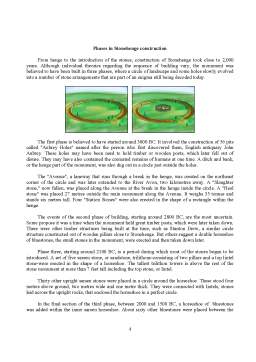Extras din referat
The megalithic ruin known as Stonehenge stands on the open downland of Salisbury Plain two miles (three kilometres) west of the town of Amesbury, Wiltshire, in Southern England.
At first sight this unique and enigmatic site appears smaller than imagined, but the tallest upright stone is 6.7m (22ft) high, with another 2.4m (8ft) below ground.
Stonehenge is surely Britain's greatest national icon, symbolizing mystery, power and endurance. Its original purpose is unclear to us, but some have speculated that it was a temple made for the worship of ancient earth deities. It has been called an astronomical observatory for marking significant events on the prehistoric calendar. Others claim that it was a sacred site for the burial of high-ranking citizens from the societies of long ago.
We can say that it wasn't constructed for any casual purpose. Only something very important to the ancients would have been worth the effort and investment that it took to construct Stonehenge.
The stones we see today represent Stonehenge in ruin. Many of the original stones have fallen or have been removed by previous generations for home construction or road repair.
In its day, the construction of Stonehenge was an impressive engineering feat, requiring commitment, time and vast amounts of manual labor. In its first phase, Stonehenge was a large earthwork; a bank and ditch arrangement called a henge, constructed approximately 5,000 years ago. It is believed that the ditch was dug with tools made from the antlers of red deer and, possibly, wood. The underlying chalk was loosened with picks and shoveled with the shoulderblades of cattle. It was then loaded into baskets and carried away. Modern experiments have shown that these tools were more than equal to the great task of earth digging and moving.
About 2,000 BC, the first stone circle (which is now the inner circle), comprised of small bluestones, was set up, but abandoned before completion. The stones used in that first circle are believed to be from the Prescelly Mountains, located roughly 240 miles away, at the southwestern tip of Wales. The bluestones weigh up to 4 tonnes each and about 80 stones were used, in all. Given the distance they had to travel, this presented quite a transportation problem.
No one can say for sure who built the monument. Seventeenth century, English antiquarian, John Aubrey, implicated the Druids, a religious sect known to worship at modern day Stonehenge. But this theory is now considered implausible. The modern Druid, possibly formed from a Celtic priesthood, is believed to have come along 2,000 years after the stone monument had been built and perhaps was in ruin. But there may not be just one answer. In the book, Beyond Stonehenge, author and modern-day astronomer Gerald Hawkins suggests that three groups of people took part in the construction.
The first may have been the secondary Neolithic people, just after 3000 BC. Next would have been the "Beaker People" named after their beaker-shaped drinking cups. The last phase, mainly stonework, may have been carried out by Wessex people. These people are known to have ties to Brittany, France, which is another culture implicated in the construction of Stonehenge by modern-day historian Aubrey Burl. Regardless of who built the stone monument, the design and construction involved thousands of people who would have needed to be believe in the project. According to Andrew Lawson, unit director of Wessex Archaeology Ltd., a company involved in fieldwork of the site, Stonehenge is less about who built it than who commanded it to be built: "So, you either have somebody who is fairly dictatorial and is capable of coercing people into doing it or it's somebody of great influence who uses some other power of suggestion to control people".
Megalithic Myth
Megalithic Myth
The story of Stonehenge wouldn't be complete without its legends. These mythical stories serve to explain the meaning of the monument, and maybe even the dangers. One such story says that the henges are gateways to where we originally came from. The legend goes on to suggest that every 5,000 years or so, someone attempts to open one of them, which brings about some horribly catastrophic event.
Evil powers have also been associated with Stonehenge. One myth tells the story of the devil who buys magical stones from an Irish woman. He transports them through the air to Salisbury Plain and then dares the entire village to count the stones in a bizarre-type of riddle. The friar of the village tells him there are too many to tell, which is based on another myth that says it is impossible to count all the stones. The devil gets so angry that he throws one of the stones at him and it hits the friar on his heel. Although the friar is unhurt, the stone is dented and has ever since been known as the Heel Stone.
But the most popular myth is a story written in the 12th century by Geoffrey of Monmouth. According to Monmouth, the king of the Britons, Aurelius, wanted to build a monument over the site of several hundred graves believed to be slain Saxon soldiers. King Ambrosius, or the father of King Arthur, asked Merlin the magician where such a monument could be found. Merlin told him to look in a mountain of Ireland where a circle of massive stones stood, named the Giant's Dance. These stones, believed to have the ability to heal, were so named after a myth that they were brought from Africa long ago by giants. King Aurelius and his army tried to dismantle the stones without success. Merlin once again came to help and used his own gear of "engines" to take apart the monument for transport.
It is only one of probably many legends that reflect the inability to explain how the heavy stones could have ever been transported by primitive humans.
Preview document
Conținut arhivă zip
- Stonehenge.doc




























